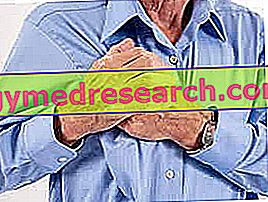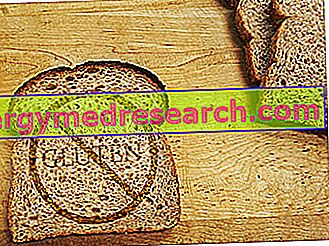Generality
Cardiogenic shock is a very serious medical condition that occurs very often following a myocardial infarction and is characterized by a reduced ventricular capacity .

The diagnosis must be made quickly, so as to put into practice as soon as possible the therapies the patient needs.
A brief reference to the anatomy of the heart
The heart is a hollow organ, composed of four contractile cavities : two are on the right and are called right atrium and right ventricle ; the other two are on the left and are called left atrium and left ventricle .
Through the atrium and the right ventricle passes the non-oxygenated blood, to be pumped towards the lungs; through the atrium and the left ventricle, on the other hand, passes the oxygenated blood to be pumped to the various organs and tissues of the body.
The pumping action is guaranteed by the muscular structure that constitutes the four cardiac cavities, called as a whole myocardium .
To regulate the flow of blood between the various compartments and between the heart and blood vessels, there are four valves, also known as heart valves .

What is cardiogenic shock?
Cardiogenic shock is a serious medical condition in which the heart (usually the left ventricle) is unable to pump adequate amounts of blood into the circulation.
MAIN CONSEQUENCES
A left ventricle that contracts inadequately leads to a reduction in the amount of oxygenated blood directed to the tissues and organs of the body. This leads to the onset of a state of tissue hypoxia (ie low level of oxygen in tissues and organs), lack of nutrients and tissue hypoperfusion (ie poor blood circulation in the tissues and organs placed in the periphery).
Very similar effects (except for tissue hypoperfusion) are also due to an inappropriate operation of the right ventricle, due to which there is a drop in the blood flow to the lungs.
Causes
The main cause of cardiogenic shock is heart attack .
In medicine, the term heart attack (or myocardial infarction ) refers to a pathological state characterized by a block of blood directed to a specific area of the myocardium, which goes for this encounter to death.
Death, called more properly necrosis, is due to the lack of oxygenation of the heart muscle tissue and causes the ventricles (for which the good health of the myocardium is essential) no longer work properly.
The larger the necrotic area, the greater the malfunctioning of the heart, which can go as far as cardiac arrest and the patient's death.
OTHER CAUSES
Cardiogenic shock may also occur due to other causes, including:
- Cardiac arrhythmias . Arrhythmias are alterations of the normal heart rhythm.
- Heart valve problems or defects (valvulopathies) . The valvulopathy that mostly leads to the onset of a cardiogenic shock is aortic stenosis.
- Cardiomyopathies . A cardiomyopathy (literally "heart muscle disease") is any anatomical modification of the myocardium, which has functional repercussions with sometimes very serious consequences.
- Myocarditis . A myocarditis is an inflammation of the myocardium.
- Impediment to ventricular contraction . The causes of this impediment include cardiac tamponade and pericarditis (the inflammation of the pericardium, the membrane that surrounds and protects the heart).
- Defects or changes in the septum that separates the atria or ventricles of the heart . For example, cardiogenic shock may be due to a rupture of the interventricular septum, ie the septum that separates the right ventricle from the left ventricle.
- Overdose (or poisoning) from drugs and other substances that alter cardiac function . Among the possible drugs responsible are beta blockers, which slow down the heart rate and are usually administered in the presence of cardiac arrhythmias.
- Post-use decompression chamber gas embolism .
RISK FACTORS
According to some statistical researches, the heart attack is more likely to cause a cardiogenic shock under these conditions:
- Old age
- Family history of heart failure or myocardial infarction
- Occlusion of the main coronaries (NB: the coronaries are the arterial vessels that carry oxygenated blood to the myocardium)
- Diabetes or hypertension
Symptoms and Complications
The symptoms and signs that characterize cardiogenic shock are the following:
- Dyspnea (or shortness of breath)
- Increased respiratory rate
- Increased heart rate (in other words, tachycardia)
- Loss of consciousness
- Weak pulse
- Sweating
- Chest pain
- Cold hands and feet. It is a natural consequence of tissue hypoperfusion.
- Pallor
- Oliguria (ie reduced urinary excretion)
- Alteration of mental state and confusion
- Hypotension
- Pulmonary edema
WHAT ARE THE SYMPTOMS OF THE HEART ATTACK?
Since the heart attack is the main reason for the onset of cardiogenic shock, it is important to remember its symptoms. The typical expressions of a heart attack are: the oppressive and increasing pressure in the chest, the difficulty in breathing, the pain in the chest, the nausea, the vomiting, the strong sweating, the dizziness and the fainting.
WHEN TO REFER TO THE DOCTOR?
At the first suspicions of a heart disorder (whether this is a heart attack or something else), you should contact your doctor immediately or go to the nearest hospital.
According to some statistical research, the sooner help is given to those who are suffering from a heart attack, the less probable is the onset of a cardiogenic shock.
COMPLICATIONS
Cardiogenic shock is extremely dangerous: once established, in fact, it is almost always irreversible and often lethal. What makes it so dangerous is the state of hypoxia that the body's tissues and organs encounter, which, without the oxygen necessary for their normal activity, suffer irreparable damage.
Among the most delicate organs and which, if damaged, can lead to death, the kidneys and liver are remembered. Kidney damage leads to kidney failure, while liver damage leads to liver failure .
Diagnosis
Given its extreme danger, cardiogenic shock must be diagnosed quickly.
The signs that can be ascertained with extreme rapidity by the doctor are hypotension, oliguria and tissue hypoperfusion.
Once it is ascertained that a cardiogenic shock is in progress and first aid is provided, the causal diagnosis is made, that is the identification of the causes that triggered the cardiovascular insufficiency. To identify the triggering causes, the following are fundamental:
- The electrocardiogram ( ECG ). Simple and non-invasive procedure, the ECG measures the electrical activity of the heart by applying some electrodes to the chest and extremity of the limbs. It is able to highlight various heart problems, including heart attack.
- The chest X-ray . It is a radiological exam that allows the visualization of the main anatomical structures of the chest (therefore also the heart). Although it is absolutely painless, it is still a minimally invasive procedure, since it exposes the patient to a minimal dose of ionizing radiation.
- The echocardiogram . Simple and non-invasive, the echocardiogram is an ultrasound examination that shows, in detail, the anatomy of the heart and any anomalies of the latter. It allows, in fact, to highlight the defects of the septum that separates atriums and ventricles, valvular defects, myocardial malformations and contraction difficulties.
- Blood tests . They include a simple sampling and allow to estimate the damage suffered by the organs and the presence of possible inflammatory states. The most important laboratory indexes for assessing cardiac damage include cardiac troponins, CPK-MB creatine phosphokinase and LDH1.
- Cardiac catheterization . This procedure involves the use of a flexible catheter, capable of spreading a contrast fluid visible to X-rays. Inserted into an important artery of the body, this catheter is carried to the heart (or one of its vessels) and is stimulated to release the contrast liquid. The diffusion of the latter allows to analyze the anatomy and the functioning of the heart, its cavities and its vessels, including the coronaries.
Cardiac catheterization is an invasive test, which requires local anesthesia.
Treatment
In the case of cardiogenic shock, the first treatments usually consist of the administration of oxygen (oxygen therapy) and of drugs with inotropic and haemofluidifying / antiplatelet action.
Therefore, if the conditions and the time available allow it, it is possible to resort to surgery or particular treatments such as angioplasty.
OXYGEN THERAPY
Oxygen therapy is the administration of oxygen through special medical instruments (some of which are also portable).
This intervention is necessary when there is a need to increase the amount of oxygen circulating in the blood and tissues.
Warning: oxygen therapy improves the symptoms, but unfortunately it does not represent a remedy for the causes that have caused cardiogenic shock.
PHARMACOLOGICAL THERAPY
Drug therapy is essential especially in the early stages of cardiogenic shock, as it avoids a worsening of the situation.
Usually, the most used medicines are:
- Positive inotropes . Their purpose is to increase the contractile strength of the myocardium. Some positive inotropes used are amiodarone, glucagon and dobutamine.
- Antiplatelet agents . They are medicines that slow down blood clotting and make the blood more fluid. A typical antiplatelet is aspirin.
- Anticoagulants . Their purpose is to slow down or stop the blood clotting process. Some examples of anticoagulants are heparin and warfarin.
- Thrombolytics . They are drugs capable of dissolving blood clots.
- The anti-arrhythmics . They are used to normalize the heart rhythm, when the latter is altered. Some antiarrhythmics are verapamil and beta-blockers.
SURGERY
The choice of the most suitable surgical procedure for the case depends on the triggering causes.
The most practiced procedures are the following: coronary bypass (ideal for patients with heart attack), repair of heart valves and septum that divides atria or ventricles (also ideal for patients with heart attack), the implantation of a ventricular assist device (useful in the presence of various cardiac disorders) and heart transplant (absolutely the most delicate of the four mentioned).
ANGIOPLASTIC AND AORTIC CONTROLLER
Angioplasty is based on the principle of cardiac catheterization and serves to "reopen" the occluded or restricted vessels that prevent blood from normally oxygenating the body's tissues. In this case, the target vessels of the procedure are the coronaries.

Figure: aortic counterpulsator.
From the site: dicardiology.com
The aortic counterpulsator (in English, it is called " intra aortic balloon pump ") is a particular device, similar to a catheter, which is inserted into the patient's aorta and serves to improve the function of the left ventricle.
Prognosis
The prognosis is almost always negative. According to some statistics, in fact, people affected by cardiogenic shock die in 70-90% of cases, due to the latter or its complication.
How to prevent cardiogenic shock (NB: the following suggestions are ideal for preventing myocardial infarction, which is the main cause of cardiogenic shock ):
- Periodically check your blood pressure and keep it at adequate levels
- Not smoking
- Maintain an adequate body weight
- Reduce fat and salt content in the diet
- Exercise regularly



